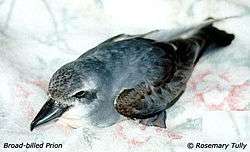Prion (bird)
| Prions | |
|---|---|
 | |
| Broad-billed prion | |
| Scientific classification | |
| Kingdom: | Animalia |
| Phylum: | Chordata |
| Class: | Aves |
| Subclass: | Neornithes |
| Infraclass: | Neoaves |
| Order: | Procellariiformes |
| Family: | Procellariidae (Leach, 1820)[1] |
| Tribe: | Prion |
| Genera | |
| Diversity | |
| 2 genera and 7 species | |
The prions (or whalebirds) are small petrels in the genera Pachyptila and Halobaena. They form one of the four groups within the Procellariidae (also referred to as the prions), along with the gadfly petrels, shearwaters and fulmarine petrels. The name comes from the Greek priōn, meaning "saw", a reference of the serrated edges of the birds' saw-like bill.[2][3]
They are found in the Southern Ocean and breed on a number of subantarctic islands. Prions grow 20 to 27 cm (7.9–10.6 in) long, and have blue-grey upper parts and white underparts. Three species of prion have flattened bills with a fringe of lamellae that act as strainers for zooplankton.[4] All prions are marine and feed on small crustacea such as copepods, ostracods, decapods, and krill, as well as some fish such as myctophids and nototheniids.
List of species
- Pachyptila
- Pachyptila turtur, fairy prion
- Pachyptila belcheri, slender-billed prion
- Pachyptila crassirostris, fulmar prion
- Pachyptila vittata, broad-billed prion
- Pachyptila desolata, Antarctic prion
- Pachyptila salvini, Salvin's prion
- Halobaena
- Halobaena caerulea, blue petrel
In addition, fossil remains of some hitherto undescribed prehistoric species have been found. The oldest comes from the Late Miocene (Tortonian, some 7 to 12 million years ago) of the Bahía Inglesa Formation in Chile.
Footnotes
- ↑ Brands, S. (2008)
- ↑ Gotch, A. F. (1995) [1979]. "Albatrosses, Fulmars, Shearwaters, and Petrels". Latin Names Explained A Guide to the Scientific Classifications of Reptiles, Birds & Mammals. New York, NY: Facts on File. pp. 191–192. ISBN 0-8160-3377-3.
- ↑ "Prion". The New Oxford American Dictionary (3rd ed.). 2013.
- ↑ Maynard, B. J. (2003)
References
- Brands, Sheila (14 Aug 2008). "Systema Naturae 2000 / Classification - Family Procellariidae -". Project: The Taxonomicon. Retrieved 22 Jul 2009.
- Cherel, Y., Bocher, P., De Broyer, C., Hobson, K.A., (2002) "Food and feeding ecology of the sympatric thin-billed Pachyptila belcheri and Antarctic P. desolata prions at Iles Kerguelen, Southern Indian Ocean" Marine Ecology Progress Series 228: 263–281
- Maynard, B. J. (2003). "Shearwaters, petrels, and fulmars (procellariidae)". In Hutchins, Michael. Grzimek's Animal Life Encyclopedia. 8 Birds I Tinamous and Ratites to Hoatzins (2 ed.). Farmington Hills, MI: Gale Group. pp. 123–127. ISBN 0-7876-5784-0.